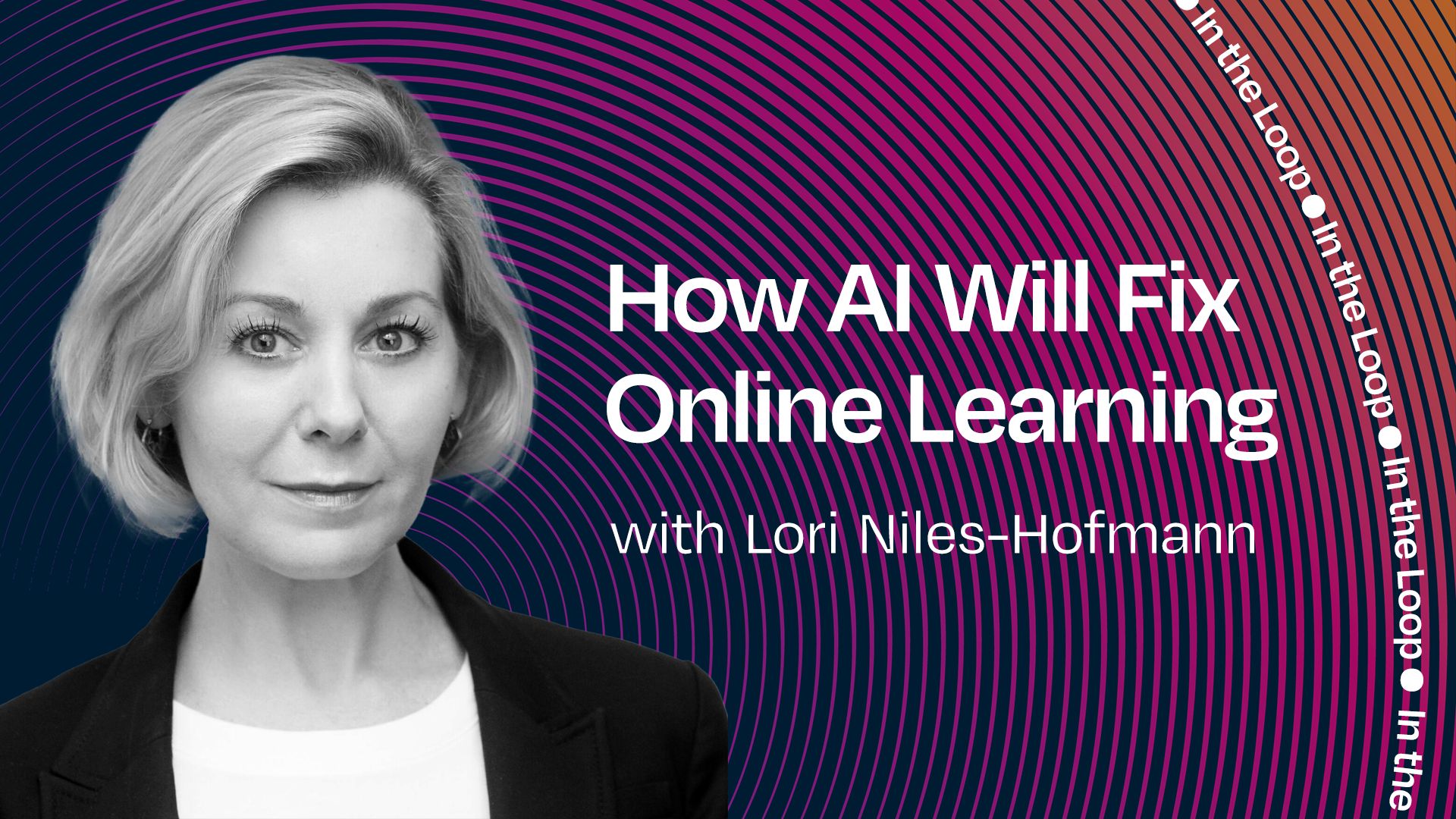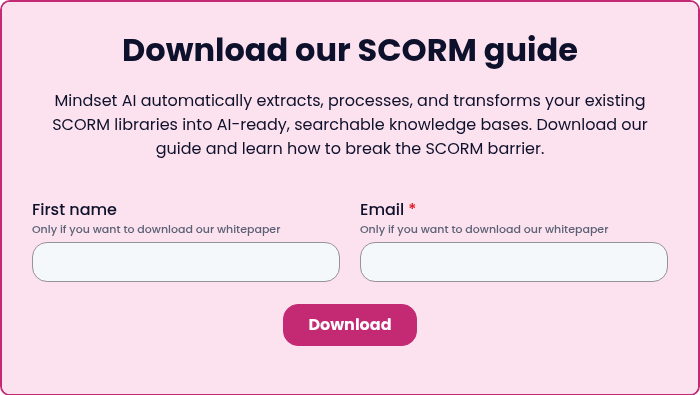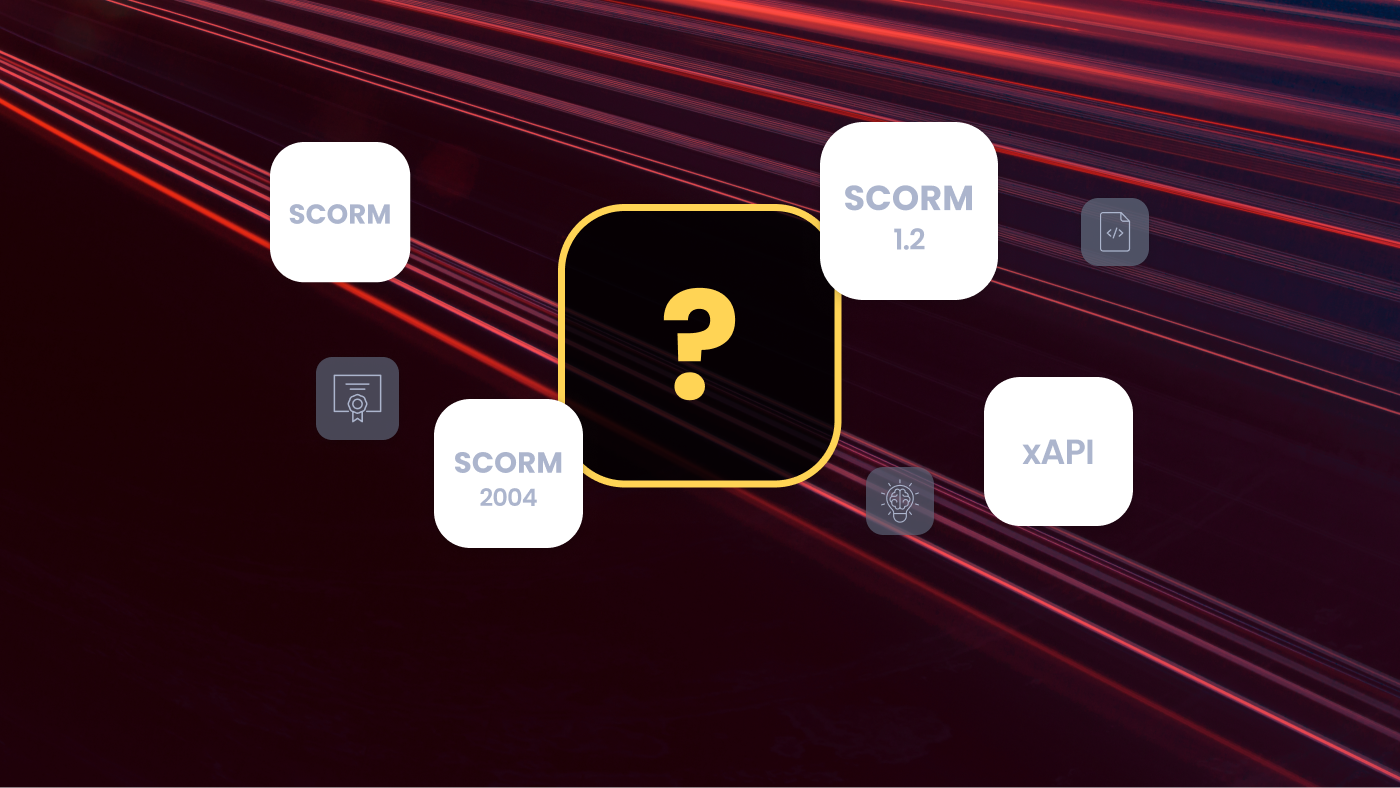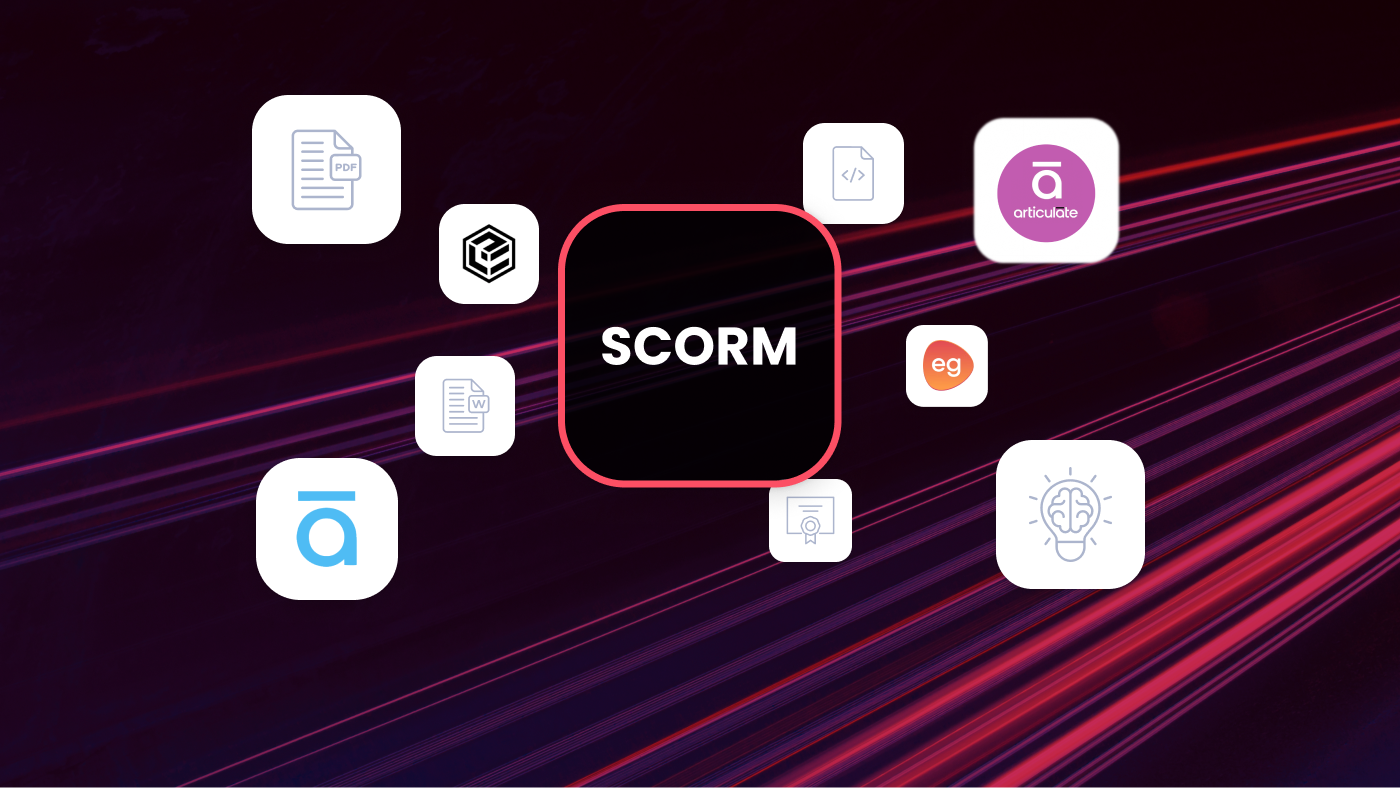Why Is Corporate E-Learning So Bad & How To Fix It With AI? | In The Loop Episode 25

Published by
Published on
Read time
Category
If you've been listening to In The Loop every week, you'll know we have high standards. We spend a lot of time finding the perfect episode, the best way to tell a story, and we care deeply about the production. Today, that means trying something new. This is our first-ever interview, and I hope you enjoy it.
I spoke to someone who has spent 25 years trying to fix what can only be described as a broken system—one that fails millions of people every day. Sitting down with her to hear her story and beliefs was a real privilege. She’s an expert in the field, a fantastic speaker, and an author. This is exactly the kind of conversation I want to bring you more of.
I'm Jack Horton, and this is In The Loop. Today, I’m investigating a question that affects every working person: what exactly is workplace learning, and why hasn’t AI fixed it yet? Meet my expert guest: Lori Niles-Hofmann.
About Lori Niles-Hofmann

Lori Niles-Hofmann is a senior EdTech strategist and author of The Eight Levers of EdTech Transformation, with 25 years’ experience across banking, consulting, and marketing. She helps Fortune 500 CLOs turn complex digital learning and skills transformations into strategic growth, while advising EdTech vendors on product vision and investors on market opportunities.
Data-driven, ecosystem-focused, and unafraid of the bold, Lori is currently exploring the possibilities of Agentic AI.
Jack: Picture this: it’s Monday morning. Sarah, a customer service manager at a Fortune 500 company, wakes up to discover she has to complete her “Digital Communications Best Practice” course by tomorrow. That’s 45 minutes of clicking through slides about not sharing inappropriate photos in a company Slack channel.
Meanwhile, another company down the road has implemented an AI system that now handles 60% of customer support inquiries—achieved in just six months. Sarah’s job may not even exist in the near future. But at least she’ll be compliant.
This isn’t hypothetical. It’s happening at companies all over the world. While the largest workforce transformation in human history unfolds, AI systems are already writing code, diagnosing diseases, creating art, and making decisions that once required entire teams of people.
Experts call this the “Great Upskill.” We need to train people quickly to do what machines can’t—creative problem-solving, emotional intelligence, complex reasoning, and decision-making. Yet the very thing that should be helping people succeed—learning at work—is often failing them.
Companies spend over $340 billion on employee training and development every year—that’s more than the GDP of some countries. And yet, when was the last time you took workplace training you actually found helpful? Relevant to your challenges? Something that made you demonstrably better at your job?
Research shows that up to 70% of training is forgotten within 24 hours. To understand this crisis, I spoke to someone who’s been inside the system. She hasn’t just seen the dysfunction—she’s lived it, breathed it, and spent her career trying to fix it. And she found a surprising source of inspiration: a hospital emergency room, a bottle of vodka, and a moment of panic at 30,000 feet.
This is the story of how workplace learning got broken—and how AI might help fix it. My guest is Laurie Hoffman, who has spent 25 years in educational technology, working as a Chief Learning Officer for major corporations and advising some of the biggest companies in the world on how to deliver truly effective learning experiences.
A legal document not working. When I dug a little deeper, I discovered that in the 1950s, people often learned through apprenticeships—working alongside masters, getting real-time feedback, and practicing skills in context.
Now, picture corporate learning today: lots of dull videos that are rarely helpful. This shift happened gradually and then incredibly fast. In the 1990s, companies began moving training online to save costs. Then, after corporate scandals like Enron and WorldCom wiped billions off the market, new laws made compliance training legally required. Suddenly, the primary purpose of corporate training shifted from developing people to protecting companies from lawsuits.
What started as a cost-saving measure became a legal necessity—and legal necessities, once embedded in corporate bureaucracy, are notoriously hard to change.
Lori: So the company says, “Well, Jack read this, so tick—Jack will not launder money.” That’s essentially how it worked.
Another issue is that many people who enter corporate learning don’t actually understand learning. They’ve gone through school and believe that because they experienced education, they automatically know how learning works. I mean, I have a passion for brain surgery, but you wouldn’t want me to perform it—on anyone living or even expired.
One of the worst examples I saw was when a company launched an internal communication tool—similar to Slack or Yammer, but before those tools became common. The training wasn’t about how to use the tool; it was essentially a list of dos and don’ts on how to behave as a decent human being.
It even included rules like, “Do not share photos depicting people without clothes on.” That doesn’t need to be an e-learning course—it’s basic code of conduct. Yet employees had to spend 45 minutes going through it. The end result? Everyone was too afraid to use the tool. The rules were so excessive—like not tagging more than three people—that it became pointless.
Jack: Lori’s example perfectly shows how compliance takes precedence over developing people. Launching a communication tool should encourage collaboration, but here it came with a 45-minute course so restrictive that people feared using it.
The resistance isn’t to development—it’s to dysfunction. But I wanted to know: why are we still stuck here? A big part of the answer lies in something most people have never heard of—yet it controls almost all corporate learning worldwide. It’s called SCORM.
Lori: SCORM is an old but once-relevant piece of technology. It stands for “Sharable Content Object Reference Model.” Back when learning was driven by compliance, SCORM made it possible to track completion:
“Jack took this hour-long course, passed the test with over 80%, here’s what he got right and wrong, here’s the date.” We’d send that to regulators so if Jack ever did something wrong, the company could say, “It’s not our fault—he passed the module.”
That’s old-school learning technology from the early 2000s.
Jack: SCORM is a technical standard—a set of rules for how e-learning should be packaged and delivered. It was created in the early 2000s with a single goal: compliance tracking.
Lori: SCORM became the required format for learning content so it could be read and understood by a learning management system. But here’s what SCORM doesn’t do: it doesn’t account for suspended data.
What do I mean by that? Let’s say you backtrack in a module, follow a branching path, watch only part of a video, or learn something outside the LMS—maybe in Slack or elsewhere. That activity often isn’t tracked as part of your learning record.
As a result, we became locked into “click next to continue” modules. Instructional designers and learning experience designers can only do so much within that framework. That’s how we ended up with endless drag-and-drop activities and the kind of boring e-learning everyone dreads—because that’s all the format allowed.
Jack: And there’s the problem: SCORM became the dominant standard that almost every LMS—the software companies use to deliver training—was built around. This is a multi-billion-dollar industry with a financial incentive to keep the system as it is.
But that raises a bigger question: if SCORM is so limiting, why hasn’t it been replaced? Why are we still stuck with a 25-year-old compliance standard in an era when personalization and adaptation should be possible, when developing people is more important than ever?
Lori: Easy answer: money.
Think about marketing—it’s about generating leads, building interest, and driving engagement that leads to a sale. Companies will happily pay for targeted ads because it reach a huge audience and drive revenue.
Learning, historically, is slower to change because the revenue isn’t in someone completing a course. There’s no direct product being purchased at the end, so the financial incentive isn’t the same.
Jack: In other words, there’s no ROI driver for innovation in learning like there is in marketing or sales technology. Marketing tech advanced rapidly because targeting and personalization directly led to more sales. But where’s the measurable return on helping someone learn better?
Lori: And here’s the challenge with AI—speaking generally, without naming specific tools—it can’t easily break into this space. The content often isn’t in a format that AI can work with. Even if it is, AI often looks for a script, and those scripts are hard to keep updated. Make a tiny change, and you have to go back, update everything, and reload it all.
Jack: Not only are we stuck with SCORM—a 25-year-old learning standard—but modern systems can’t actually help us escape it because AI can’t read that format. It’s like being trapped in a digital time capsule.
Lori: That’s the other barrier: content needs to be ingested and integrated into what’s essentially a knowledge management plus L&D system. Imagine L&D speaks German, knowledge management speaks French, and your AI agent or coach also speaks French. The agent can only pull from the French source, not the German one. That’s the analogy.
Jack: The irony is almost painful. We live in an age where AI could transform learning experiences, but for AI to understand the material, it would need to understand SCORM—and it can’t. The result is a technical standard holding an entire industry hostage.
Luckily, Lori discovered something that could change everything—and it came from an unexpected place. She’s about to tell a story involving airport vodka and a medical emergency. While it might sound like a detour, it contains the key to understanding how we can fix learning.
Lori: I’m afraid of flying. I was in North Carolina and had to take a tiny 12-seater plane from Raleigh, North Carolina, to Toronto—and there were storms in the forecast. I was not happy. Don’t judge me, but I started looking for a place to have a glass of wine.
There was no bar in that part of the airport. So I went to a duty-free shop and bought the only option—a one-liter bottle of vodka. I figured I’d make myself a small drink. But the clerk told me, “You don’t get this until you land. We can’t give it to you now.”
I told a woman at the gate that I was terrified of flying. She said, “Okay, as soon as your plane lands, run to the other terminal, grab a glass of wine, then come back, and I’ll get you on the next flight.”
The plane landed, she gave me the nod, and I sprinted to the other terminal, got my wine, came back, and boarded. I survived the flight—it was rough—but when we landed, I was so tense that I wrenched my back while lifting my luggage.
They put me in a wheelchair and wheeled me through the airport. I was crying, mascara running, and then the flight attendant came up to me, caught a whiff of wine on my breath, and handed me my one-liter bottle of vodka. That’s how I ended up being pushed through Toronto Pearson Airport, clutching it.
Jack: But the story doesn’t end there—what happened next completely changed how Lori thought about learning.
Lori: The point is, my husband had to take me to the hospital because I couldn’t move—everything had seized up. That’s where I saw the process used when you enter A&E.
You aren’t seen by a nurse right away. First, there’s a kiosk that asks you questions: Are you experiencing heart palpitations? Do you have chest pain? Are you running a fever? Where have you traveled? (This was even before COVID.) It also took my blood pressure using an automated cuff. It even asked, Are you conscious?—which I thought would be obvious if I were answering all the other questions.
That triage information was then sent to a nurse, who decided who would be seen first. They assessed everyone in the waiting area and determined the order based on urgency and the availability of the right specialists. You weren’t seen in the order you arrived—you were seen according to the severity of your condition and the resources available.
Now, flip that into learning. If you took all learning requests and just put them in order as they came in, it would be like making someone having a heart attack wait while someone with a splinter gets treated first. That’s not effective. It wastes resources and doesn’t help the business.
Jack: This is the fundamental insight into how workplace learning could be revolutionized. Right now, most corporate learning operates like a fast food restaurant—everyone gets the same thing in the same order. But what if it could operate like an emergency room—personalized, prioritized, and optimized for real needs?
We still face the problem, though: the world of learning is built around SCORM compliance and annual planning cycles that make agility almost impossible.
Lori: That’s because of the way L&D is set up—especially in enterprise organizations. For listeners in mid-sized or smaller companies, you’re probably more agile because you haven’t had to deal with this kind of structure.
In an enterprise with, say, 50,000 employees, the budget is set at the start of the year. They decide what they’re going to build, and then comes what I call the bun fight. Business partners all gather in a room, each with their “wish list” of learning projects for the year. The business signs off on the plan and allocates the budget, and performance reviews for the L&D team are tied to whether they hit those agreed-upon targets.
Jack: Now, picture this happening across an entire organization. In January, you’re planning the skills people will need in December. By the time December arrives, those skills may be completely irrelevant because the world has changed—but the money has already been spent on SCORM courses.
Lori: One example I share in the book is from a bank where we implemented a central intake—similar to that kiosk at A&E where everyone checks in. We introduced a simple form asking, “If you’re working on anything in learning, just fill this out and let us know.” Through that, we discovered 17 separate learning units—this was a global financial institution—all building Agile courses. The cost was astronomical.
One version was IT-specific because their processes differ slightly. The other was a general version pushed out from global. By consolidating, we eliminated 15 redundant pieces of content.
Think about the downstream impact for learners. They log into their LMS, search “Agile,” and find 17 different courses. They have no idea which one to choose. That’s not helping them—it’s confusing them.
Jack: This is what the emergency room model could bring to workplace learning. Instead of everyone receiving the same generic course, people get exactly what they need, when they need it, delivered by the right specialist.
But to implement that vision, you can’t just change processes. You also need the right technology—and that’s where AI comes in.
Lori: Learning is most effective when it’s personalized to the individual. You can’t force every need into the same box. For a long time, we made learning static—the same for everyone—with that “click next to continue” model.
Effective learning should be hyper-personalized. It should know you, know what you’re working on, understand your day, your meetings, your projects—and deliver content in a way that’s contextually relevant.
It should also focus on impact. If the learning isn’t having an impact, it should pivot in ways that will. It’s about looking at what’s working and making adjustments so it’s truly successful.
Jack: Personalization gets talked about a lot, but what does it actually look like in practice?
Lori: I know some people aren’t fans of the model, but Duolingo is a fascinating example of how data and AI can be used to personalize and improve learning.
In L&D, we tend to deliver static courses. Good learning, though, creates opportunities to practise, revisit, and connect—perhaps with a virtual coach that evaluates your performance and gives tailored feedback. It is not the generic “You got that wrong, let’s try again,” but feedback that’s specific to what you did and how it maps to the company’s performance standards.
All of those elements together make for an impactful learning experience.
Jack: Imagine learning that understands your calendar and current projects, adapting to your real work context. Instead of a generic course on communication skills, you’d get targeted coaching on how to handle a difficult stakeholder you’re meeting tomorrow.
That’s a closed-loop system—something SCORM could never deliver—where learning measures actual behaviour change and adapts in real time.
But Lori takes it a step further—envisioning learning that breaks away from the traditional “course” format entirely.
Lori: The example I gave in the book was this: you go onto a learning system or an app, and you do level four Spanish. What happens is, we know that level four Spanish means you're probably at a pretty good level, so the next time you log into Slack or any of your work tools, it'll come up and say, “Hola, do you want to change your language settings to Spanish?” to give you that type of practice and hands-on experience. And that creates a whole other learning experience. Then we start to see how well you're doing with that, and we might say, “Hey, we see a lot of progress. Do you want to be connected with this person in Colombia who's working on a project similar to yours?” and start that conversation.
Now you see how I've taken language learning. The person is probably still taking their courses or whatever—Babbel or Duolingo or whatever they're using for Spanish—and probably getting tutoring, but now it's embedded into the way they're actually working and behaving day to day. That's how we need to think about learning. It's not just the course—the course isn't going to be the same as what you would log into for a standard program. There’s tutoring, feedback loops, and practice. All of these things are embedded, and they're delivered at times that work with how I'm performing day to day. Maybe it has access to my calendar, or it knows from the CRM what customers I'm speaking to.
So it feeds all of that into creating a learning experience that is truly pertinent to me. I actually predict that you'll have a learning coach—and I hate using “learning agent” because I know I’m bastardizing the term agent—but you will have an AI companion who knows everything you’re working on. It reads your emails, observes your interactions, anticipates challenges, and coaches you through them. It knows what you’ve done well, your past experiences, and serves up not only knowledge but critical learning experiences aligned with company and personal goals.
In the future, when it comes to skills, the system will know, “We need 16 people with this skill.” Your coach will talk to you about this skill and see if you can be nurtured along the way. It’ll be precise. Of course, it will include all the good things—a coach that embeds practice and feedback—but it will also tie outcomes to actual performance. Honestly, in three years, the line might blur—you may have this AI companion in your personal life as well. I already do. Ask your AI tool to tell you your three best and worst personality traits, and it will know things about you. Companies might want to tap into the personal AI as well, but I think there will still be a divide.
Jack: But here's the thing—this isn’t some distant future vision for SCORM and e-learning in general. This technology already exists. Companies are beginning to implement these kinds of systems and mindsets to make it happen. This is exactly what we do at Mindset AI.
Lori: Definitely. I’m trying not to name companies, but there’s one I really adore. They’ve figured out how to combine productivity, knowledge management, and learning and development. They’re measuring it from a productivity standpoint, and they’ve seen massive increases.
Jack: To conclude, the learning trap is real, but it’s not inevitable. We’re stuck with systems designed 25 years ago for legal compliance, not growth. SCORM—the technical standard most people never hear about—has imprisoned corporate learning into a “click next to continue” world. The real revelation came from Lori’s emergency room story involving a bottle of vodka at Toronto Airport. She discovered the solution: triage learning should work like an emergency room—prioritized by need, context, and optimized for actual impact.
The technology to fix this already exists. Mindset AI can transform your SCORM library and then create learning coaches that know your work, adapt to your schedule, and provide just-in-time support. Mindset AI works with companies to implement this technology into their learning ecosystem, even enabling ingestion of SCORM. The learning trap, therefore, is not permanent. People want to learn—they just don’t want to do it in a dysfunctional way.
Lori: People are always learning. They’re learning in ways you might not see.
Jack: That’s it for today. I hope you enjoyed the episode. Lori is a fantastic speaker. If you want to contact her, we’ll include all her info in the description. Comments or feedback? Drop me a message on whatever channel you prefer. I’ll see you next week.
Book a demo today.




.png)
.png)
.png)
.png)
.png)
.png)
.png)
.png)
.png)

.png)
.png)


.png)
.png)
.png)

.png)
.png)


.png)
.png)
.png)
.png)
.png)
.png)

.png)
.png)
.png)
.png)
.png)
.png)
.png)
.png)
.png)


.png)
.png)
.png)

.png)
.png)
.png)

.png)
.png)
.png)



.png)






.jpeg)